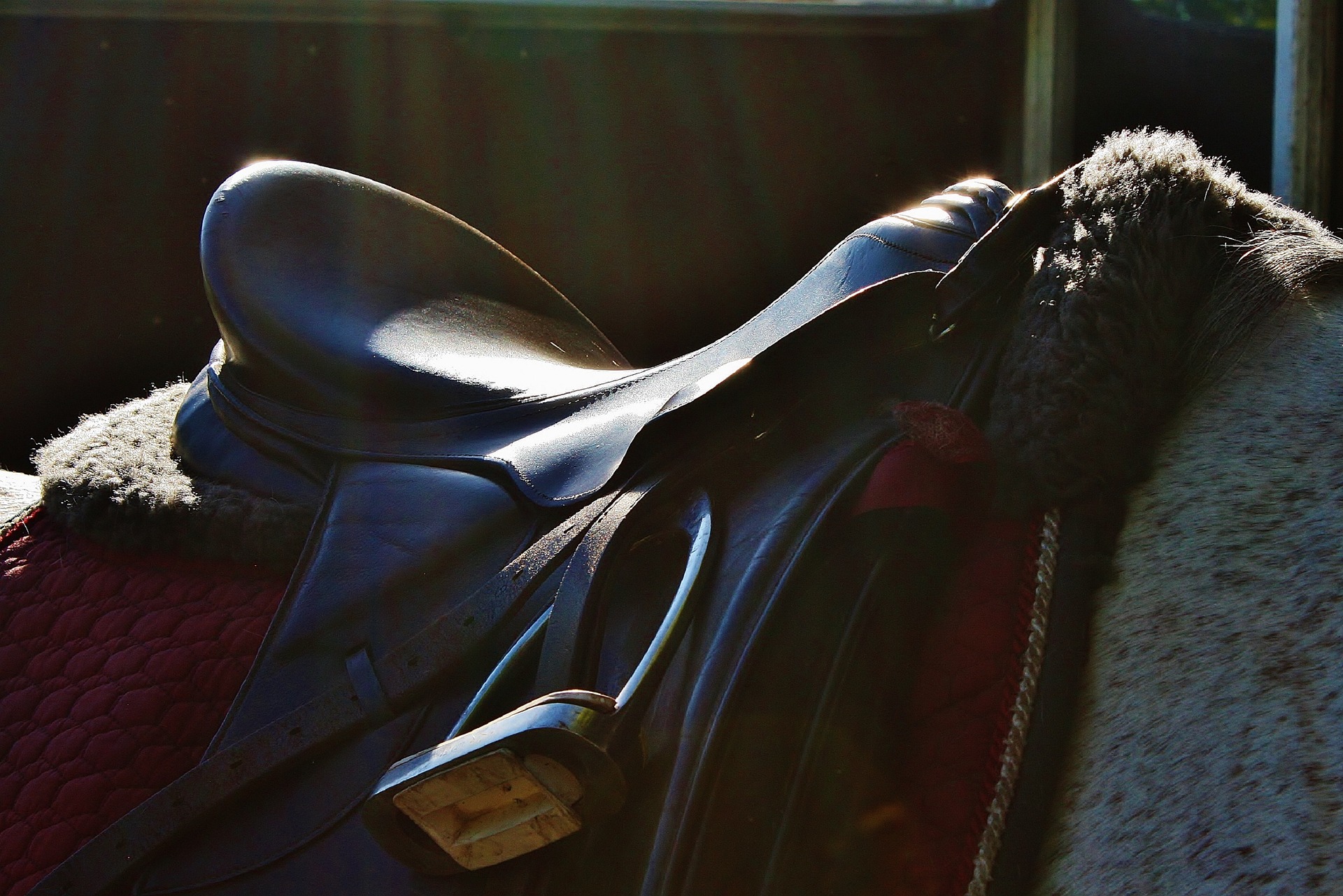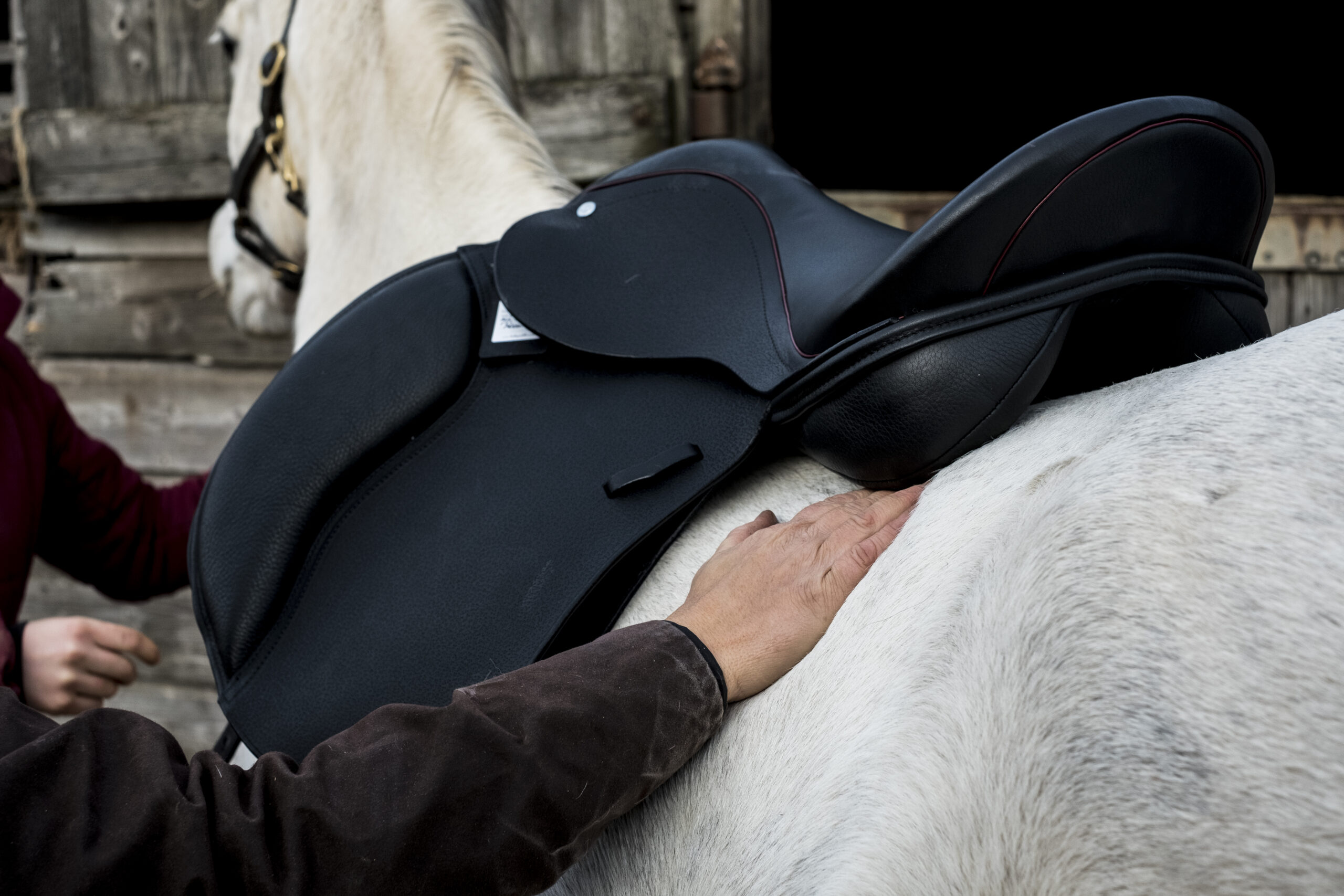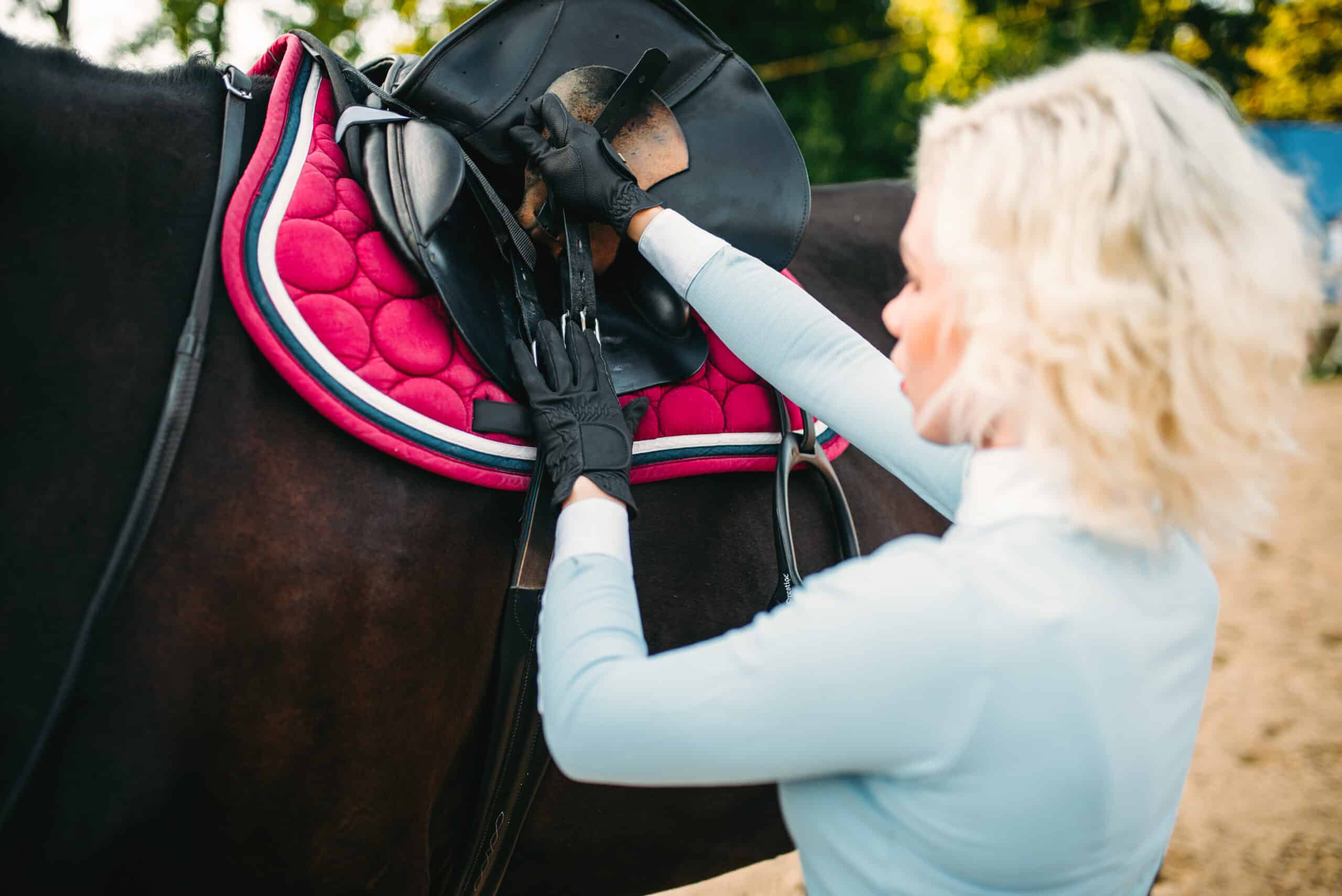Measuring a Western saddle and an English saddle follows a similar process. The main difference is between the flap and saddle skirt measurements.
Measuring a Western saddle involves determining the skirt length, seat size, and saddle width. For English saddles, you will need to measure the flap length and flap angle instead of the skirt.
You can measure saddles in inches or centimeters. Some manufacturers will provide this information, and the units used will depend on where the manufacturer or seller is located.
You don’t need special equipment to determine seat size, skirt length, flap length, saddle width, or most other dimensions since they’re all straight-line measurements. If you’re not sure how to choose a saddle based on those figures, consider asking a vendor, saddlemaker, or other professional.
Keep in mind that you may need different saddle styles and sizes for various horses and activities. Not all horses can wear the same saddle designs, and saddle fitting may be needed to ensure that a saddle fits properly without irritating the horse’s back or shoulder blade.
You should also keep your own needs in mind. Consider whether you might need to adjust a design or purchase a particular type of saddle for your own comfort.
If you have longer legs or want to match your current saddle, these factors can influence your selection of saddle. It isn’t all about what works with your horse.
Key Parts Of A Saddle
Before measuring a horse saddle, it’s important to understand each of the parts and how they contribute to the overall makeup of the saddle. Although this isn’t an all-inclusive list, it will help you recognize each saddle component when it’s time to measure.
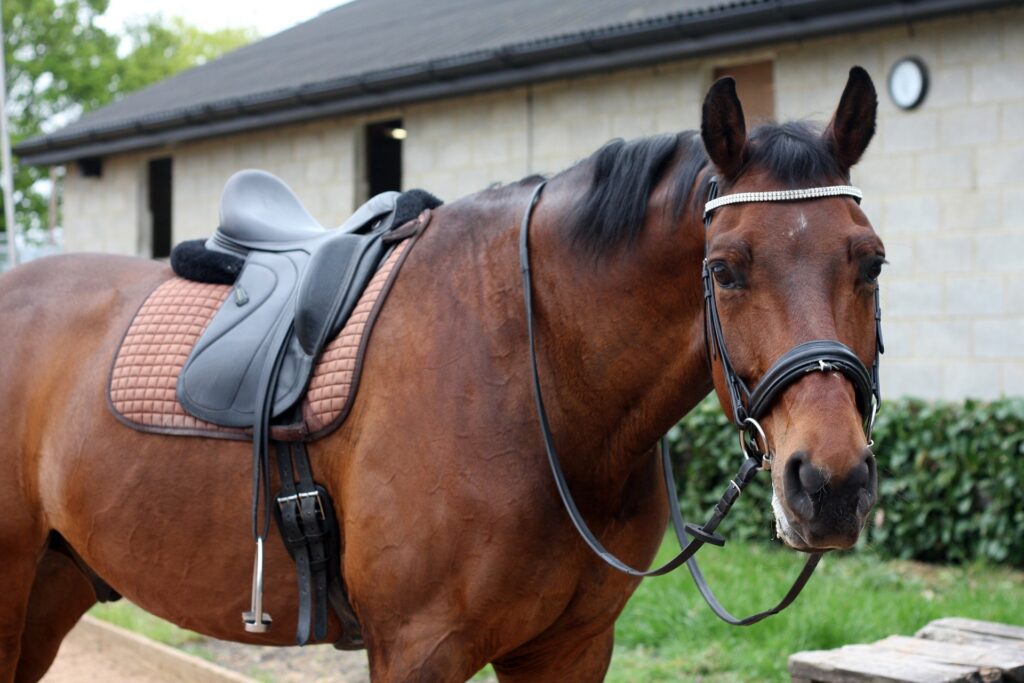
The tree is the base of the saddle and what gives the saddle its shape. Most saddle trees are made from wood. The tree is covered with leather or synthetic materials as well as padding to make the saddle more comfortable.
The saddle bars are the part of the tree that sit on the horse’s back. They significantly affect whether an English or Western saddle will sit balanced on a given horse based on that horse’s measurements.
The gullet sits on top of the horse’s withers. The gullet width can be narrow, wide, or in a middle range depending on the horse.
The front of the saddle is the pommel or swell, and the back part is the cantle. These can both affect the size of the seat or how spacious it feels.
A Western saddle skirt surrounds the seat of the saddle and helps keep it in place. On English saddles, the saddle flap covers the stirrup leathers and buckles on the saddle. Both protect the rider’s leg and the horse from irritation.
Why Saddle Size Matters
Saddle size is about more than just comfort. It’s also a matter of safety that protects a horse from injury due to poor saddle fit. A saddle that doesn’t fit properly can wear on the horse’s shoulders or the horse’s withers.
Over time, this could lead to damage as pressure points wear on the skin, causing swelling or saddle sores. If these sores persist even after switching saddles or making changes, consider a formal saddle fitting. A saddle fitting can identify pressure points, and the fitter will be able to suggest ways to reduce friction and pain.
It isn’t always easy to recognize signs of poor saddle fit. Even something as simple as a patch of white hair on a horse’s shoulder blade could indicate that there’s a problem.
You should also use your knowledge of each horse and saddle to investigate a potential issue. For instance, if you have a particularly heavy Western saddle that’s causing a horse back pain, the issue may be the weight of that Western saddle compared to a lighter English model. The problem isn’t always a matter of measurements.
Before saddling up, a good rider will check their horse’s scapula and back for any signs of soreness or injury. Even though a saddle sits on a horse’s back, it’s also wise to check the horse’s belly to ensure the girth or cinch isn’t causing irritation.
A horse that’s exposed to poor saddle fit for too long might develop behavioral problems because the saddle irritates the horse’s back, making the horse more likely to resist wearing a saddle. In fact, unexplained changes in mood or temperament can be one of the first warning signs that something is wrong with the horse’s health.
With both an English or Western saddle, you should make sure that your saddle pad doesn’t change the fit of the saddle alone. There are also other specialty pads such as a shoulder bridge pad that go underneath a saddle pad to fill out gaps between the saddle and the horse’s back.
Posture And Rider Health
In addition to considering your horse’s body condition and dimensions, the wrong saddle size can negatively impact you as the rider. If you’re not using the right saddle with the proper seat for your body, you could accidentally put yourself at risk of injury.
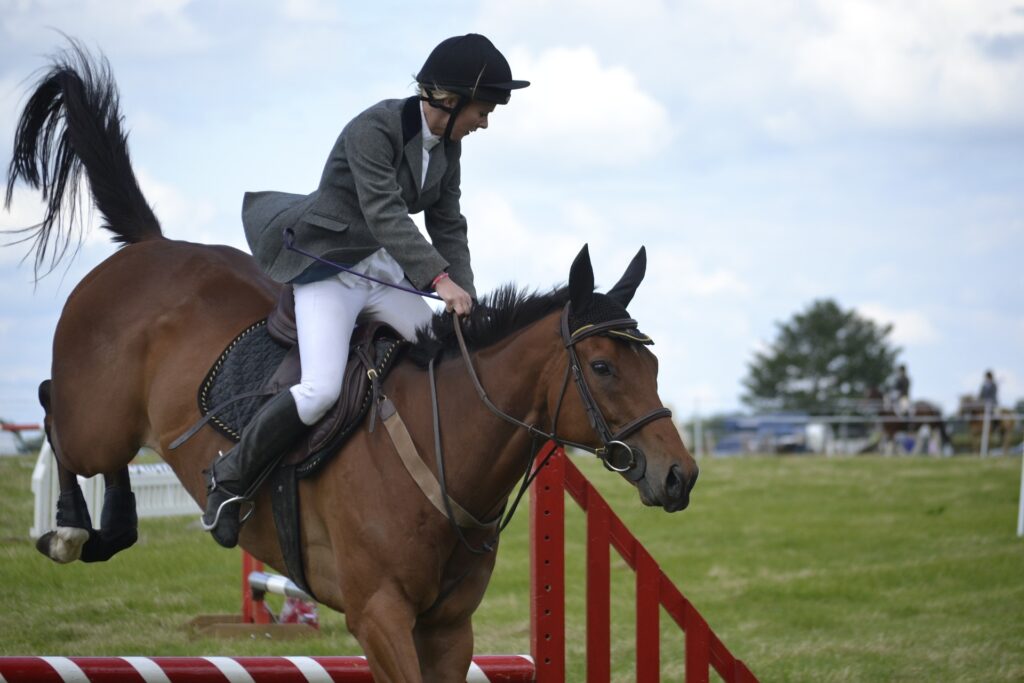
The size of a saddle’s seat can affect your posture and how you distribute your weight while riding. Think about how you feel after a ride to ensure the saddle fits both you and your horse.
Back or knee pain could signal improper fit or that you’re overcompensating with certain parts of your body to stay in the saddle. While this may not seem too bad after a gentle trail ride, these imbalances can lead to chronic injuries, especially if you’re engaging in high-impact riding, jumping, or heavy ranch work.
How To Measure A Saddle
Measuring an English or Western saddle is a simple process. The first step is to ensure the saddle is on level ground so that you aren’t accidentally measuring on a diagonal.
For a Western saddle, the easiest way is to look at the front of the saddle and measure where the bars attach just below the conchos where the saddle bars of the tree connect to the saddle.
This will give you the gullet size. On a Western saddle, a gullet size of approximately 6.25 inches to 6.75 inches will fit most horses.
To measure the tree width on an English saddle, turn the saddle upside down and look for a pair of felt dots by the gullet. Measure from one dot to the next to determine the tree width.
You can check measurements by putting the saddle on your horse and using your hand as a guide. If you can fit your hand in between your horse’s withers and the gullet, the saddle is likely too narrow and sitting up high from your horse’s back.
If you can barely fit a fingertip in between or you can see that the gullet is directly on your horse’s withers, the saddle is sitting too low and needs to be replaced with a narrower model.
Seat Size
For seat size, use a measuring tape to measure from just behind the horn and pommel at the front of the saddle to the front edge of the cantle in the rear.
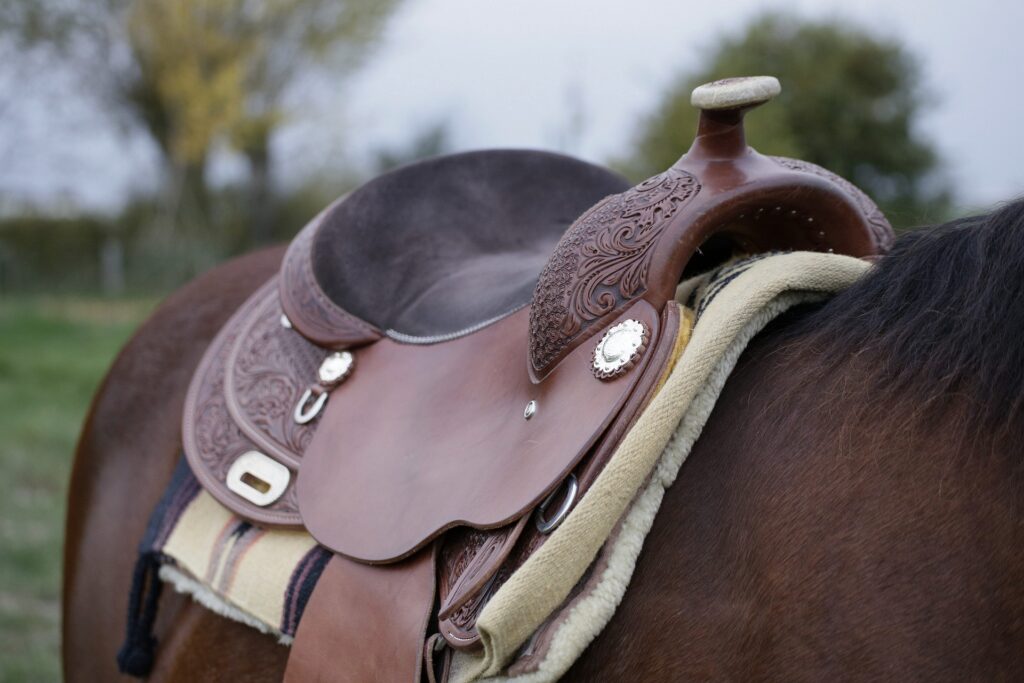
To some extent, the type of horse saddle will also impact a saddle’s measurements and how the rider perceives the seat size. A dressage saddle, for instance, is likely to have a higher cantle and pommel to help the rider feel more stable.
However, the higher cantle and pommel can make the saddle seat seem smaller because there’s less of an open platform. Saddles with a lower cantle or pommel made for jumping or racing may feel like they have more room.
That’s why it’s important to consider how the saddle seat size feels compared to just its actual measurements on paper. Saddle fit is critical for the safety and comfort of the horse, but you also have to consider your own comfort and whether the saddle fit is right for your preferred riding position.
Flap And Skirt Length
On English saddles, other helpful measurements include the following:
- The distance between the front of the flap to the middle of the saddle’s cantle in the rear
- The distance between the nail at the pommel to the front of the flap
- The length and width of the saddle flap
For Western saddles, the skirt size is another part of proper fit. The skirt on a Western saddle shouldn’t cover the horse’s hip.
Although a square skirt is more common on a Western saddle, you may prefer to use a Western saddle with a round skirt based on your needs. A saddle with a round skirt is usually lighter and more appropriate for a horse with a short back since too long of a skirt can change the balance of the saddle or cause pain.
Sizing According To Breed
Some breeds of horses have unusual or distinct features that make it difficult for them to wear saddles made using a standard saddle tree and average measurements. Before using a saddle with a breed that falls into this category, it’s best to measure and assess the saddle fit to confirm that the saddle has the right tree, design, and gullet size.
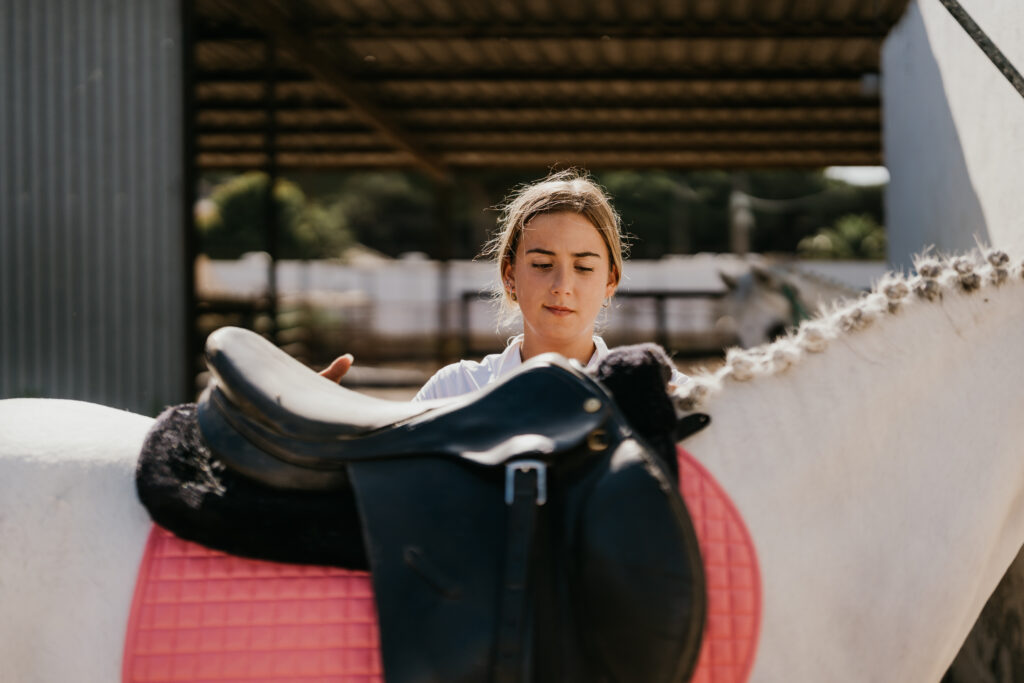
Arabians, for example, tend to have short backs, wider chests, and flat withers. To match that body type, Arabian saddles have a narrower gullet measurement and a less dramatic bar angle.
Draft horses like Percherons and even draft crosses tend to have wider backs and lower withers. These horses often need saddles with a wide tree or extra-wide tree that can fit their broader body style without creating pressure or pinch points.
While there are exceptions for every breed, it’s best to keep these considerations in mind while you shop to give you a good starting point. You can also simply visually evaluate your horse to estimate the proper gullet width and whether you might need a narrow tree or wide design.
There are also subcategories of some breeds that further complicate sizing and matching the tree to the horse. A good example of this is the American Quarter Horse. Quarter Horses fall within three general categories: hunter/racing, stock, and halter.
Stock Quarter Horses are on the smaller side and tend to be popular for Western events and ranch work. Horses of the halter type are larger and more muscular, while those of the hunter/racing category are tall, slimmer, and built for speed.
Therefore, the right saddle size and tree for one type of Quarter Horse won’t necessarily work for all horses of that breed. Although there may be an average in the middle, it’s best to think in terms of individual horses instead of using breed as a metric.
Saddle Seat Sizes
When discussing saddle dimensions, it’s important to distinguish between the measurements for the horse and the measurements that affect you as the rider. The size of a saddle’s seat must match you just as much as the gullet of the saddle must match your horse.
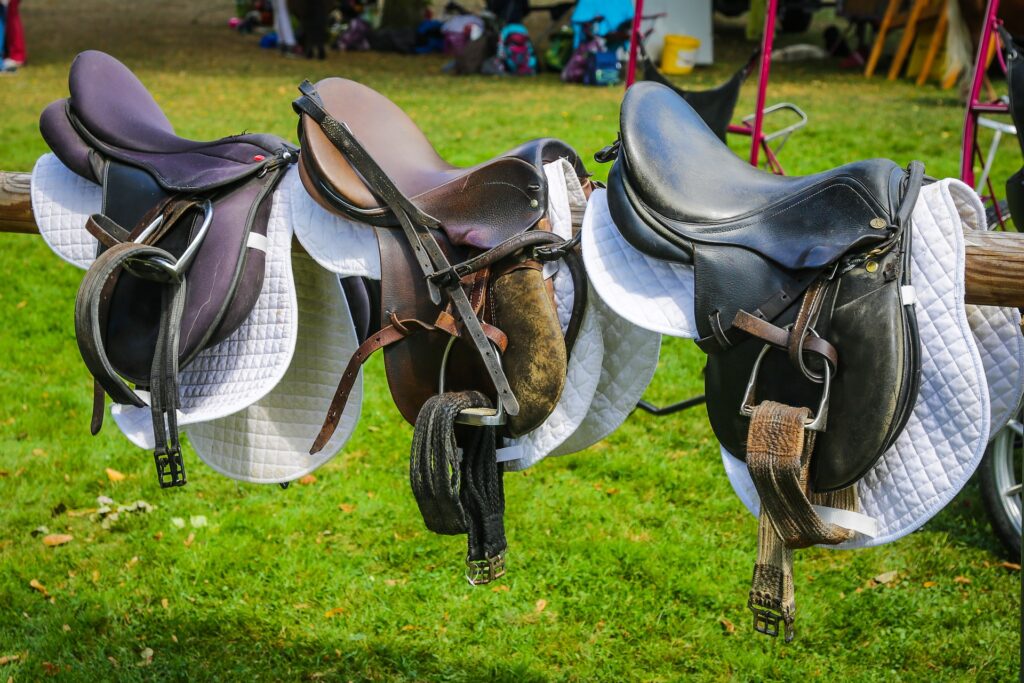
Like so many other factors, seat sizes are different between a Western saddle and an English saddle. For Western saddles, seat sizes tend to fall into five categories ranging from 12 inches through approximately 17 inches. These groups include:
- Youth: 12–13 inches
- Small: 14 inches
- Standard: 15 inches
- Large: 16 inches
- Extra large: 17 inches
English saddles are usually within 14 inches to 19 inches. Even half an inch can make a substantial difference in saddle fit. The sizes can are roughly as follows:
- Youth: 14–15 inches
- Small: 15.5–16.5 inches
- Standard: 17 inches
- Large: 18 inches
- Extra large: 19 inches
Since an English saddle will usually run slightly larger than a Western saddle seat size, it’s important to keep the measurements separate between the disciplines. Buying an English saddle based on a Western saddle seat size can be an expensive mistake.
For riders who may only need a smaller seat for a few months or a year, it may be better to consider used saddles instead of buying new. For example, a child who will quickly outgrow a saddle could move up multiple sizes in a short period of time.
Final Thoughts
Overall, it can be very simple to measure an English or Western saddle using just a tape measure. This can be an essential part of riding responsibly and ensuring that your saddle is right for both you and your horse.
For a Western saddle, you’ll need to measure the seat, tree size, and seat dimensions. For an English horse saddle, you should check flap length, width, and angle instead of the skirt.
Measuring a saddle will help you ensure that you’re using the proper tree size for your horse and yourself. This reduces the chances of injury all around and improves comfort while you ride.
Although there are many ways to estimate fit based on breed, visual appearance of a saddle, or saddles your horse has worn in the past, it’s best to always confirm that a saddle is the best design for your horse. As horses age and grow, they may need a different tree width or skirt length, so don’t assume that one fitting is all you need.
Frequently Asked Questions (FAQ):
What units are used to measure Saddles?
The units of measure used for saddles will vary based on the area. When purchasing a new saddle, the manufacturer will decide how to list these measurements. American-made saddles are likely to use inches, while most other countries will use the metric system. When measuring a horse’s height, many riders and horse owners use hands, a traditional term in horsemanship meaning 4 inches.
Are all Saddles the same size?
No, each saddle will have its own dimensions, saddle seat size, and design. There’s no standardization between saddles because, much like clothing sizes for people, horses will have their own unique body shapes.
One horse’s withers won’t be the same as another’s. A horse’s back might be unusually shaped or too long to accommodate certain saddles. Therefore, saddles are available in different sizes to ensure that everyone can access a saddle that will properly fit their horse.
Will Horse Saddles fit a Pony?
No, it’s highly unlikely that even a small horse saddle would fit a pony. Since ponies have much shorter backs than horses, a horse’s body requires a completely different design. Therefore, it’s best to choose a pony saddle for a pony and a horse saddle for a horse to ensure proper saddle fit.
Are Western Saddles bigger than English Saddles?
Yes, the average Western saddle will always be bigger and heavier than the average English saddle in physical size. In fact, even the basic design of the saddle tree differs between these two disciplines. The overall size shouldn’t be confused with seat sizes since an English saddle will have larger dimensions in the actual seat than a Western saddle.

